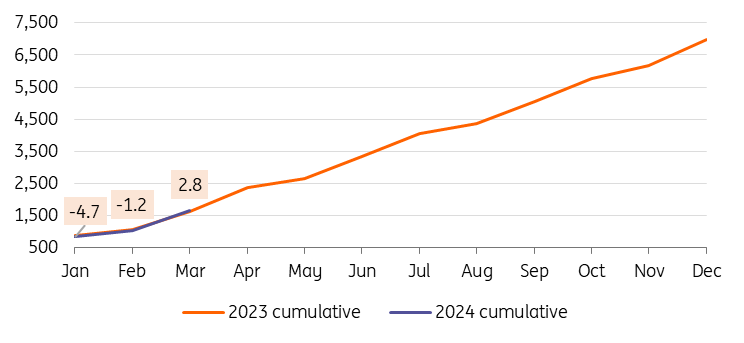No one saw this strong Hungarian retail performance coming. The March data surprised to the upside, without any early hint. So, we take it with a pinch of salt, but file it away as a possible ray of hope for recovery.
The development of Hungarian retail sales in March was a rather strong positive surprise. On a monthly basis, after a contraction of 0.6% in the previous month, sales volumes across all sectors rose by 2% in seasonally- and working-day adjusted terms. The dynamic one-month growth also led to a strong improvement in the year-on-year index, which rose by 4.2%, adjusting for the calendar effect. Such a spectacular pace of expansion was not at all expected by the analyst community, especially in light of the preliminary release of first quarter GDP, where retail trade was not highlighted as a strong performing sector.
Looking at the details, the most influential surprise came from food sales, which showed dynamic growth in March after February. It is quite rare for this subsector to post consecutive monthly growth rates close to 1%. However, this could be due to the Easter effect, although calendar-adjusted data should (in theory) take care of this. Non-food sales also showed a significant correction after the decline in February. On a monthly basis, we saw an increase of 0.9% in this segment. There was also strong growth in sales of books, newspapers and second-hand goods.
Breakdown of Retail Sales (% YoY, wda)
Source: HCSO, ING
We saw a correction in mail order and internet sales, which rose by almost 2% after a sharp fall in the previous month. Sales in stores selling higher-value goods (such as electronics, furniture, etc.) also increased somewhat, but the performance was rather below average. It would therefore appear that the coupon payments on retail government bonds (together with the accumulation of transfers in previous months) have already had some positive impact on retail sales in March. It remains to be seen, however, why this did not boost purchases of big ticket items to a greater extent. Last but not least, fuel sales were also somewhat puzzling, as fuel prices continued to rise by 2.1% month-on-month in March. In fact, sales rose by 0.5% on a monthly basis.
All in all, therefore, the March retail sales data in many ways added to the plethora of questions rather than answering some of them. In light of today's data, it will therefore be even more important to look at the detailed GDP data, which may provide some explanation. Fundamentally, of course, real wage growth and a trend improvement in household confidence could explain the expansion in retail sales, but this is unlikely to be seen as a sudden rebound after two months of poor performance. Moreover, developments on the revenue side of the budget did not necessarily foreshadow this surge either. While VAT receipts in the first quarter of 2023 reached 23% of full-year receipts, in 2024 this share (relative to expected full-year receipts) was 19%. However, to be fair, the year-on-year performance is clearly improving.
The year-to-date development of VAT receipts (HUF bn)
Source: Hungarian State Treasury, ING. Note: Data labels are referring to the year-on-year change
By historic standards, retail sales turnover volume is now at levels last seen in the summer of 2021, following the surge in March, so the overall picture is also improving, but a full recovery is still some way off.
Retail Sales volume in detail (2021 = 100%)
Source: HCSO, ING
In the coming months, relatively low inflation and, as a result, strong real wage growth should support retail sales. Similarly, the inflation-linked coupon payments on retail government bonds may have an increasing impact on consumption. At the same time, households need to become less cautious and confidence needs to recover (remember that the latest consumer confidence reading surprised on the downside with a decline) before there can be talk of a sustained recovery. But there are undoubtedly already encouraging signs, even if many questions remain.
Read the original analysis: Hungarian Retail Sales surge raises some questions
Content disclaimer: This publication has been prepared by ING solely for information purposes irrespective of a particular user's means, financial situation or investment objectives. The information does not constitute investment recommendation, and nor is it investment, legal or tax advice or an offer or solicitation to purchase or sell any financial instrument. Read more here: https://think.ing.com/content-disclaimer/
Recommended Content
Editors’ Picks
EUR/USD stays in positive territory above 1.0850 after US data

EUR/USD clings to modest daily gains above 1.0850 in the second half of the day on Friday. The improving risk mood makes it difficult for the US Dollar to hold its ground after PCE inflation data, helping the pair edge higher ahead of the weekend.
GBP/USD stabilizes above 1.2850 as risk mood improves

GBP/USD maintains recovery momentum and fluctuates above 1.2850 in the American session on Friday. The positive shift seen in risk mood doesn't allow the US Dollar to preserve its strength and supports the pair.
Gold rebounds above $2,380 as US yields stretch lower

Following a quiet European session, Gold gathers bullish momentum and trades decisively higher on the day above $2,380. The benchmark 10-year US Treasury bond yield loses more than 1% on the day after US PCE inflation data, fuelling XAU/USD's upside.
Avalanche price sets for a rally following retest of key support level

Avalanche (AVAX) price bounced off the $26.34 support level to trade at $27.95 as of Friday. Growing on-chain development activity indicates a potential bullish move in the coming days.
The election, Trump's Dollar policy, and the future of the Yen

After an assassination attempt on former President Donald Trump and drop out of President Biden, Kamala Harris has been endorsed as the Democratic candidate to compete against Trump in the upcoming November US presidential election.


